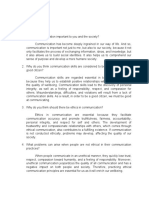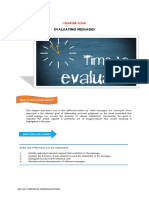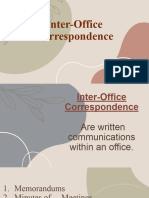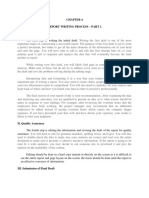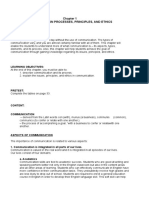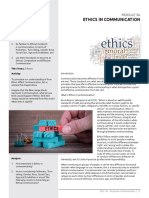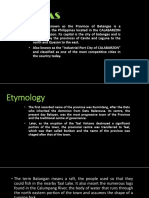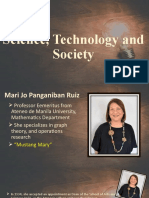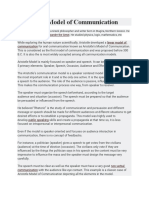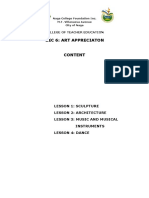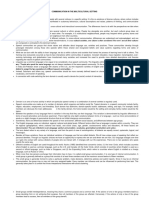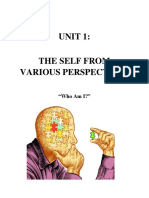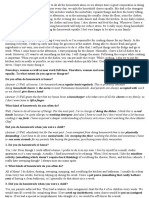Purposive Communication Module 1 2021
Uploaded by
John CayabyabPurposive Communication Module 1 2021
Uploaded by
John Cayabyab001-Rev-
2020
REMOTE LEARNING MODULE
COURSE TOPICS and DATE of 1st Year 1st Semester
SUBMISSIONS:
INSTRUCTOR’s PROFILE Lesson I: Communication PURPOSIVE
Process, principles and COMMUNICATION
ethics
(Week 1)
This course is about writing,
speaking, and presenting to different
Lesson II: Communication
audiences and for various purposes.
and Globalization (Week 2)
It is a three-unit course that
Lesson III: Local and Global develops students
Lerma V. Regalario, MAEd, SMRIEdr Communication in ‘communicative competence and
Instructor Multicultural Settings enhances their cultural and
• Varieties and intercultural awareness through
[email protected]
Registers of Spoken and multimodal tasks that provide them
0955426348
Written Language (Week 3) opportunities for communicating
I am a licensed professional teacher, effectively and appropriately to a
with Bachelor’s degree in Industrial Lesson IV: Evaluating the multicultural audience in a local or
Psychology, Certificate in message and/or images of global context.
Professional Education different types of texts
Specialization-English, Master’s reflecting different cultures It equips students with tools
degree in English Studies and (Week 4) for critical evaluation of a variety of
Instruction, and currently working texts and focuses on the power of
on Ph.D. in Management major in language and the impact of images to
Lesson V: Communication
English emphasize the importance of
Aids and Strategies Using
Presently, I am a Senior Member of conveying messages responsibly.
Royal Institute of Educators, Tools of technology (Week
Singapore, a Platinum Member of 5) The knowledge, skills, and
Instabright International Guild of insights that student gain from this
Researchers & Educators, and Lesson VI: Communication course may be used in their academic
Professional member of Institution for Various Purposes (Week endeavors, their chosen disciplines,
for Engineering Research and 6-8) and their future careers as they
Publications (IFERP), Ateneo Center
compose and produce relevant oral,
for English Language Teaching Lesson VII: Communication
(ACELT) Teachers Club, and
written, audio-visual and/ or web-
for Work Purposes (Week 9- based output for various purposes
Literature Educators Association of
11)
the Phil. Inc. (LEAP)
Students may contact me from Lesson VIII: Communication
Monday to Friday every 1pm to for Academic Purposes
4pm. (Week 12-18)
This learning material is for educational purposes and AiTECH uses only. P a g e 1 | 11
001-Rev-
2020
REMOTE LEARNING MODULE
1st Year 1st Semester This module was made and written to address your learning
needs in this time of pandemic. Through this, you will be able to delve on
PURPOSIVE the course at your own pace. Multimodal resources such as visual and
COMMUNICATION electronic devices assisted were included to prepare you communicate
effectively in the multicultural setting
Week 1
TASK 1. (5 points)
COMMUNICATION PROCESS, In one minute, list at least 10 words that you might think when you
PRINCIPLES AND ETHICS hear the word “COMMUNICATION.”
Learning Outcomes:
Now, analyze the two models of communication. Write a short
description of each.
describe the nature, elements,
What is in figure 2 that is not present in figure 1?
and functions of verbal and non-
Which do you think is more effective? Why? Support your answer.
verbal communication in various
and multicultural context
Illustrate the process of
communication
Source and References:
Suarez, C. et.al, (2018) Purposive
Communication in English. Ateneo de
Manila University Press
Fig. 1: Shannon-Weaver Model
Wakat, G. et.al, (2018) Purposive
Communication. Lorimar Publishing,
Inc.
Online materials and videos
https://www.communicationstudies.c
om /communication-process
Einstein, M. (2014). The 7Cs of
Communication and Email.
emailoverloadsolutions.com.
https://www.emailoverloadsolutions.
co m/blog/7cs-of-communication-
and- email
Angela Markel Chancellor of Germany
https://youtu.be/uLfukuEutIU
“Pinoy English” by Filipino-Canadian
Mikey Bustos
https://youtu.be/UqlFT8zT8V8
https://youtu.be/21hYyR9xxAc
This learning material is for educational purposes and AiTECH uses only. P a g e 2 | 11
001-Rev-
2020
REMOTE LEARNING MODULE
TAKEAWAYS
Communication comes from the Latin word ‘communis’, which means ‘commons’. To be common means
“to come together” or “to commune”- “to share something in common”.
Communication is the process of sharing ideas, information, and messages with others in a particular time
and place. It includes writingand talking, as well as nonverbal communication (such as facial expressions, body
language, or gestures), visual communication (the use of images or pictures, such as painting, photography, video,
or film), and electronic communication (telephone calls, electronic mail, cable television, or satellite broadcasts).
Communication is a vital partof personal life, business, education, and any other situation where people
encounter each other.
NATURE OF COMMUNICATION
Communication is a process.
Communication occurs between two or more people (the speaker and the receiver).
Communication may be expressed through words (verbal), actions (nonverbal), or both at the same time
Do you consider talking to yourself a form of communication? Why?
Process of Communication
The speaker generates an idea.
The speaker encodes an idea or converts the idea into words, or actions.
The speaker transmits or sends out a message.
The receiver gets the message.
The receiver decodes or interprets themessage based on the context.
The receiver sends or provides feedback
Communication Principles and Process
How we communicate depends on who we are talking to, the topic we are discussing, and when
and where the conversation is taking place.
There are three important factors to consider whenever we are engaging into verbal communication.
1. Audience- group of people whose backgrounds concerns and interests may shape the
way themessage is received.
2. Context-conditions that shape the contents of the message such a significant period, or the sender’s
background and experiences.
3. Purpose-concrete set of objectives or reasons for addressing a specific audience.
This learning material is for educational purposes and AiTECH uses only. P a g e 3 | 11
001-Rev-
2020
REMOTE LEARNING MODULE
When a person sends a message with a specific purpose to a certain audience, one must ensure
of practicing ethics in communication. That is anticipating the effect of the message to the audience.
Remember: Before your scheduled talk, research first who will be your audience, adjust your talk based
onthe target audience, and use language that are clear, concise, and courteous.
FEATURES OF AN EFFECTIVE COMMUNICATION
An important principal in communication theory is the 7Cs of communication, which was developed in a 1952 book,
Effective Public Relations, by University of Wisconsin professor's Scott Cutlip and Allen Center.
1.Completeness
The primary message must include all the necessary facts and information. The message should also take into
consideration the intended recipient and their perception of the world.
2. Conciseness
A concise message means communicating what you need to express in the least possible words. It means that the
message does not contain excessive or unnecessary words or information.
3. Clearness (Clarity)
Clearness in communication implies the use of specific, concrete, and appropriate words to fit the goal being
discussed.
4. Consideration
To be effective, the speaker should take into account the viewpoint of the audience, their background,
education, experience, and attitudes. and gear the message towards their thinking and beliefs.
5. Concreteness
Concreteness increases the confidence of the message and builds on the reputation of the message. As a speaker,
you should support your message with relevant facts, figures, and examples.
6. Correctness
An effective message is syntactically and grammatically correct, and with the appropriate use of language. It makes
use of precise and accurate facts and figures.
7. Courtesy
A message shows courtesy when it is positive, unbiased, focused at the audience, and uses language that shows
respect; thus, the speaker is considered by recipient to be polite, friendly, and enthusiastic.
Questions:
The 7 C’s in communication was developed in 1952, do you think it is still useful and applicable nowadays? Why? Cite
instances where 7C’s may be able to assist you in communicating in multicultural context.
This learning material is for educational purposes and AiTECH uses only. P a g e 4 | 11
001-Rev-
2020
REMOTE LEARNING MODULE
MULTIMODAL COMMUNICATION
You may be able to communicate your thoughts through different modality such as graphic images, memes,
videos, essays, speech, sound, and physical gestures.
TASK 2. (20 points)
Directions: Watch the two videos and answer the questions below.
A copy of the video is available on the google classroom and on the email address you provided. You may watch
the video through this link: Video 1: https://youtu.be/uLfukuEutIU
Video 2: https://youtu.be/21hYyR9xxAc
Questions:
1. What message was shown by President Trump to Germany’s Chancellor Angela Markel?
2. Comment on how President Donald Trump regard woman with the attitude he shown during the meeting.
3. Based on video number 2, Why do you think Poland’s First Lady Agata Kornhauser-Duda pass President
Trump’s hand and instead handshake with the first lady of US Lady Melania Trump?
4. What message was being shown by Poland’s First Lady with her actions?
5. Discuss how emotions and body language effectively speaks in these videos.
VERBAL AND NONVERBAL COMMUNICATION
Verbal Communication refers to the interaction in which words are used to relay a message,
while nonverbal communication used gestures, facial expression, and behavior to convey and
represent meanings. All kinds of human responses that are not expressed in words such as stares,
smiles, tone of voice, movements, manners of walking, standing, sitting, appearance, style of attire,
attitude towards punctuality and space, and personality are classified as nonverbal communication.
Knowledge on verbal and nonverbal elements of communication in a multicultural setting will
lead toa happier adventure, while ignorance might lead to troubles and mishaps.
In verbal communication, language use in terms of word choice is a vital element in
understanding the community. Knowledge on the use of slang by a certain group, use of jargon
by a particular group of professionals, and euphemisms and double speak are significant to
consider when you engage in communication with people of different culture. It is also best to
think of the denotative meaning or the lexical definition of a term, as well as the connotative
meaning which is based on how the words are used. Word choice may include the following:
1) Slang is a type of language that consists of words and phrases that are regarded as very
informal, are more common in speech than writing, and are typically restricted to a particular
context or group of people. "grass is slang for marijuana"
2) Jargon is a technical language that used by professionals in a certain field. It includes special
words or expressions that are used by a particular profession which may be understood
differently by another group.
This learning material is for educational purposes and AiTECH uses only. P a g e 5 | 11
001-Rev-
2020
REMOTE LEARNING MODULE
3. Euphemism and double speak are choices in language that hide certain truths. The purpose of euphemism is to
make a concept or idea more acceptable. These are polite, indirect expressions that replace words and phrases
considered harsh and impolite, or which suggest something unpleasant. For example, “kick the bucket” is a
euphemism that describes the death of a person.
4. Double speak may be more misleading as it tends to cover up a difficult reality of an issue. These words that
appear at first glance to mean one thing but actually hide (or even reverse) their true meaning. Example: when
a company "downsizes," that actually means a lot of people are losing their jobs. Instead of a blunt,
straightforward word or phrase, doublespeak uses euphemisms and ambiguity to disguise or soften a
message. Military leaders might refer to "servicing the target" when they mean dropping bombs, and a used car
salesman most likely prefers describing older vehicles as "pre-owned."
Analyze the images below. Supposed you are scheduled to report a certain topic in Purposive
Communication and your classmates are looking at you this way.
1) Explain what these nonverbal cues want to convey to you.
2) How did you understand their message?
3) What actions/changes are you going to do with your reporting based on the message
of youraudience?
(Source: https://www.scienceofpeople.com/microexpressionsactions)
UNDERSTANDING COMMUNICATION IN MULTICULTURAL CONTEXT
TASK 3. (10 points)
Directions: Watch a YouTube video entitled “Pinoy English” by Filipino-Canadian
Mikey Bustos.You may watch the video through this link:
https://youtu.be/UqlFT8zT8V8
A copy of the video is also available on the google classroom.
T Answer the following questions:
1. Enumerate the Pinoy English expressions from the video.
ASK 4.2.(20
Write instances when you use those Pinoy English expressions.
points)
3. Discuss the reasons why we---Filipinos have different ways of using English based on our context.
Directions: Read the text below. Analyze how food shapes communication in multicultural context.
This learning material is for educational purposes and AiTECH uses only. P a g e 6 | 11
001-Rev-
2020
REMOTE LEARNING MODULE
The writer: Shaima Al Tamimi (@iamshaima)
Shaima is a 26 year old Emirati, who loves to immerse
herself in all things fresh and interesting. She loves to
travel, observe people and experience new cultures.
Universal Language of Food Her quarterly column “Food for Thought” discusses
by Shaima Al Tamimi (@iamshaima) important social topics from thought provoking
perspectives. Shaima is also a food blogger.
https://sailemagazine.com/author/shaimaaltamimi/
1. If there is one thing that amazes me in this world, it would be the universal language of food. Globally,
people can speak different languages, live different lives and lead separate lifestyles. But in the end,
food is the one thing we all have in common and one of things that brings us all together. After all,
“man’s gotta eat”.
2. To me, food is not just about curbing one’s hunger or the act of merely dumping fruits and vegetables
into your system. It is about so many other things that define us as human beings apart from being a
means to survive. The language that food speaks to me is representing culture, traditions and above all
love. No matter what part of this earth you are from, you are bound to have a totally unique experience
into the culture of a country through food.
3. In many cultures, food plays a significant part in defining family roles and tradition. More often than
not, it is a symbol or token of hospitality, appreciation and respect. Picture an Arabic family gathered
on the floor for a feast meal of rice and meat (normally known as Dhebeeha). If the head of a goat is
served on a tray, and knowing that it is the most prized part of any livestock, that part would be
automatically given to the boss of the family or the most noted person sitting around the meal. It is one
of the ways in which the head symbolizes utmost respect, which is why in Arabic we have a saying that
goes “Al Ra’s lil ra’ees” meaning “the head for the king”.
4. cross all cultures however, compassion is what it is when you distribute a hot plate to the needy. It
reminds us to always remember the less fortunate and not take our blessings for granted. So always
make sure you do not hastily waste it. If you have leftovers, re-create another dish out of it. Be playful,
but respectful in utilizing it.
5. Comfort is what food brings on a gloomy cold day and the only thing that could lift up your damp spirits is a
hearty bowl of lentil soup or a cup of hot chocolate whilst you are wrapped under a warm blanket. Food is
also comfort when you are mad at the world and suddenly find yourself embracing a bucket of ice cream
before plunging to the binge.
This learning material is for educational purposes and AiTECH uses only. P a g e 7 | 11
001-Rev-
2020
REMOTE LEARNING MODULE
6. Food is love when a loved one spends time in the kitchen to prepare a meal for their family to
lunch or dine over. It is certainly love when you gather together as a family to eat and end
up sharing stories of your day and cracking jokes.
7.Food conjures memories when baking brownies with your kids and you pretend to not notice
that they lickedthe sinfully yummy chocolate batter off the bowl whilst you were not looking. It
is also nostalgic in that certain tastes and aromas can take you back to a different time or place
and make you reminisce over the good old days of your childhood or kitchen disasters in the
dorms.
8.Have you ever thought of all the ways in which food speaks to people and above all bring them
together? I guess the reason I am writing about this is to shed some light on the important role
the food plays in our lives.That said, it surprises me how nowadays people do not care to go
through the length of preparing it. Instead, they order take-out and dine out more often than
enjoying a home cooked meal. To me, that is like almost stripping off half the fun by taking
such shortcuts. Do not you get a sense of achievement after making something from scratch
and have everyone gobble it down in minutes?
9. Ok, so you can’t cook well, but like everything else you learned to do, practice makes perfect.
If you can maketime for certain things in your life, you can certainly accommodate an hour of
your time to know what you arefeeding yourself. Get back to basics, quitting relying on
outsourcing your food and have fun in the kitchen. It is the most powerful way to show love
and it creates fond memories like no other.
Source: https://sailemagazine.com/2011/06/the-universal-language-of-food/
Questions:
1) In what way does food bring us together?
2) Enumerate how food was used to communicate in nonverbal manner in Arab family?
3) Is it used the same way in Philippines? Support your answer.
4) What attitudes and feelings were associated with food in the selection?
5) Cite some instances when you used food in communication.
This learning material is for educational purposes and AiTECH uses only. P a g e 8 | 11
001-Rev-
2020
REMOTE LEARNING MODULE
Check your takeaways on the topic.
A. Fill in the blanks.
1. _____is the process of sharing ideas, information, and messages with others in a particular time
and place.
2. Speaker, _____, encoding, channel, decoding, receiver, feedback, context, and _____ are
elements of communication
3. Effective communication considers completeness, conciseness, clearness, consideration,
concreteness, correctness and _____.
4. Verbal Communication refers to the interaction in which are used to relay a message,
while nonverbal communication refers to an interaction where is used to convey and
represent meaning.
5. Slang is a type of language that consists of words and phrases that are regarded as very
informal, common in speech than writing, and typically restricted to a particular context;
while _____is a technical language that used by professionals in a certain field.
B. Explain in 3-5 sentences the communication principles and process involving audience,
context andpurpose.
ASSESSMENT.
D i r e c t i o n s : Read the sentences carefully and choose the best answer.
Write only the letter of your choice.
1.The factors that affect the flow of communication is the _.
a. barrier b. context c. feedback d. receiver
2. It is the process interpreting the message of the speaker by the receiver.
a. encoding b. decoding c. feedbacking d. reacting
3.The special words or expressions that are used by a particular profession or group and are
difficult for others to understand is a
a. euphemism b. doublespeak c. jargon d. slang
4.Body language, facial expressions, and tone of voice convey thoughts and emotions in a _
a. verbal form b. communication c. non-verbal manner d. fashionable way
5. Communication should include everything that the receiver needs to hear from him/her to
respond, react, or evaluate properly. It is essential to the quality of the communication process
in general. The feature of an effective communication discussed is
a. conciseness b. courtesy c. correctness d. completeness
This learning material is for educational purposes and AiTECH uses only. P a g e 9 | 11
001-Rev-
2020
REMOTE LEARNING MODULE
6. By respecting the culture, values and beliefs of the receiver, the speaker shows___ in communication.
a. clearness b. courtesy c. correctness d. completeness
7. In communication, it implies the use of simple and specific words to express ideas. It is also achieved
when the speaker focuses only on a single objective in his/her speech so as not to confuse the
audience.
a. clearness b. courtesy c. correctness d. completeness
8. Statement 1: Communication can be expressed through verbal and nonverbal cues.
Statement 2: Communication is the process of sharing ideas, information, and messages with others in a
particular time and place
a. Statement 1 and 2 are both correct. c. Only statement 1 is correct.
b. Statement 1 and 2 are both wrong. d. Only statement 2 is correct.
9. Statement 1: Effective verbal communication use words to express ideas which can be easily understood
by the person you are talking to.
Statement 2: Appropriateness, clarity, and ethics are significant in verbal communication.
a. Statement 1 and 2 are both wrong. c. Only statement 1 is correct.
b. Statement 1 and 2 are both correct. d. Only statement 2 is correct
10. Statement 1: In communication, the target audience is an important factor to consider.
Statement 2: The conditions that shape the contents of the message are the significant period, and the
sender’s background and experiences.
Statement 3: Purpose are the concrete set of objectives or reasons for addressing a specific audience
a. Statement 1 is wrong. c. Only statement 1 is correct.
b. Statements 1, 2, and 3 are correct. d. Only statement 2 is correct
This learning material is for educational purposes and AiTECH uses only. P a g e 10 | 11
001-Rev-
2020
REMOTE LEARNING MODULE
Name of Lerma V. Regalario
Student: Instructor:
SCORE/REMARKS September 12
Date of
Submission
Date of Submission 1
Module #
Answer Sheet Template
Submit your answer in the module with the following format.
Task 1: (5 points)
Task 2: (20 points)
Task 3: (10 points)
Task 4: (20 points)
Check your takeaways on the topic.
A. Fill in the blanks. 5 points
B. Communication principles and process. (10 points)
Assessment (10 points)
This learning material is for educational purposes and AiTECH uses only. P a g e 11 | 11
You might also like
- Chapter 2 - Public Speaking and Reports in The Information AgeNo ratings yetChapter 2 - Public Speaking and Reports in The Information Age6 pages
- Purposive Communication Lesson 3 Communication Multicultural ContextsNo ratings yetPurposive Communication Lesson 3 Communication Multicultural Contexts4 pages
- Module 2 - Communication and GlobalizationNo ratings yetModule 2 - Communication and Globalization5 pages
- Module 1 Introduction To Social EntrepreneurshipNo ratings yetModule 1 Introduction To Social Entrepreneurship35 pages
- What Are The Communication Models? Why Do You Think They Were Introduced? There Are A Total of 5 Communication Model100% (1)What Are The Communication Models? Why Do You Think They Were Introduced? There Are A Total of 5 Communication Model2 pages
- Gned 05 PPT Culture and Intercultural CommunicationNo ratings yetGned 05 PPT Culture and Intercultural Communication41 pages
- Purposive Communication in The 21st Century by Magan At. Al. 2020100% (1)Purposive Communication in The 21st Century by Magan At. Al. 20205 pages
- My Reflection On The Self As A Product of SocietyNo ratings yetMy Reflection On The Self As A Product of Society1 page
- UST (1) - Apalis - Trisha - Ann - Morales - BSN1GNo ratings yetUST (1) - Apalis - Trisha - Ann - Morales - BSN1G3 pages
- Chapter 1 - COMMUNICATION PROCESSES, PRINCIPLES, AND ETHICSNo ratings yetChapter 1 - COMMUNICATION PROCESSES, PRINCIPLES, AND ETHICS7 pages
- Belief Systems and The Conduct of BusinessNo ratings yetBelief Systems and The Conduct of Business24 pages
- Batangas: - Officially Known As The Province of Batangas Is ANo ratings yetBatangas: - Officially Known As The Province of Batangas Is A31 pages
- Role of Communication in International TradeNo ratings yetRole of Communication in International Trade3 pages
- 5 Single Space of Size 18: College of Arts and SciencesNo ratings yet5 Single Space of Size 18: College of Arts and Sciences32 pages
- Purposive Communication MODULE 2020 TEJIDONo ratings yetPurposive Communication MODULE 2020 TEJIDO152 pages
- Purposive Communication: at The End of The Unit, The Students Are Expected To Have: Learning Outcomes100% (1)Purposive Communication: at The End of The Unit, The Students Are Expected To Have: Learning Outcomes6 pages
- CULTURAL VALUES: Guidelines For BehaviorNo ratings yetCULTURAL VALUES: Guidelines For Behavior4 pages
- Davao Doctors College, Inc. Student HandbookNo ratings yetDavao Doctors College, Inc. Student Handbook107 pages
- Unit I Geed 10063 Purposive CommunicationNo ratings yetUnit I Geed 10063 Purposive Communication83 pages
- Communication in The Multicultural SettingNo ratings yetCommunication in The Multicultural Setting8 pages
- Communication According To Context Part 1No ratings yetCommunication According To Context Part 142 pages
- Module 2: Communication and GlobalizationNo ratings yetModule 2: Communication and Globalization17 pages
- GED 106 PURCOM Midterms Reviewer Invitation To EditNo ratings yetGED 106 PURCOM Midterms Reviewer Invitation To Edit7 pages
- Purposive Communication Chapter 2 Communication and GlobalizationNo ratings yetPurposive Communication Chapter 2 Communication and Globalization8 pages
- Pergunta 1: Resposta Resposta Selecionada: E. Resposta Correta: E. Feedback Da RespostaNo ratings yetPergunta 1: Resposta Resposta Selecionada: E. Resposta Correta: E. Feedback Da Resposta4 pages
- My Family Is Aware How Difficult It Is To Do All The Housework Alone So We Always Have A Good Cooperation in Doing Household ChoresNo ratings yetMy Family Is Aware How Difficult It Is To Do All The Housework Alone So We Always Have A Good Cooperation in Doing Household Chores7 pages
- E-Book Kemungkaran Wanita Di Bulan Ramadhan (Seri 3) Syahrul Fatwa All Chapter Instant Download100% (1)E-Book Kemungkaran Wanita Di Bulan Ramadhan (Seri 3) Syahrul Fatwa All Chapter Instant Download52 pages
- Immediate download A Taste of Well Being Sadhguru s Insights for Your Gastronomics 1st Edition Isha Foundation ebooks 2024100% (4)Immediate download A Taste of Well Being Sadhguru s Insights for Your Gastronomics 1st Edition Isha Foundation ebooks 202455 pages
- BRL-012 (Visual Merchandising& Store Management)No ratings yetBRL-012 (Visual Merchandising& Store Management)15 pages
- Level 6 Mock Paper 17 Digital Pioneer 30492340 AnswersNo ratings yetLevel 6 Mock Paper 17 Digital Pioneer 30492340 Answers7 pages
- Let's Eat!: Let's Read A Story About You and Your Friend PennyNo ratings yetLet's Eat!: Let's Read A Story About You and Your Friend Penny54 pages
- Bourbon - The Rise, Fall, and Rebirth of An American WhiskeyNo ratings yetBourbon - The Rise, Fall, and Rebirth of An American Whiskey244 pages
- Salale Oromo Women Songs of Resistance (By Asafa Tafarra Dibaba, Indiana University, USA)100% (1)Salale Oromo Women Songs of Resistance (By Asafa Tafarra Dibaba, Indiana University, USA)46 pages
- All Infinite Craft Recipes and Combos - Dot EsportsNo ratings yetAll Infinite Craft Recipes and Combos - Dot Esports1 page
- Tourism in Jammu and Kashmir: Presented By: Saddam Hussain 1 Year Mba, Jkshim, NitteNo ratings yetTourism in Jammu and Kashmir: Presented By: Saddam Hussain 1 Year Mba, Jkshim, Nitte23 pages
- Active and Passive Voice Edit New - 054900No ratings yetActive and Passive Voice Edit New - 0549003 pages
- Britannia Company Profile: Eat Healthy, Think Better'No ratings yetBritannia Company Profile: Eat Healthy, Think Better'1 page


